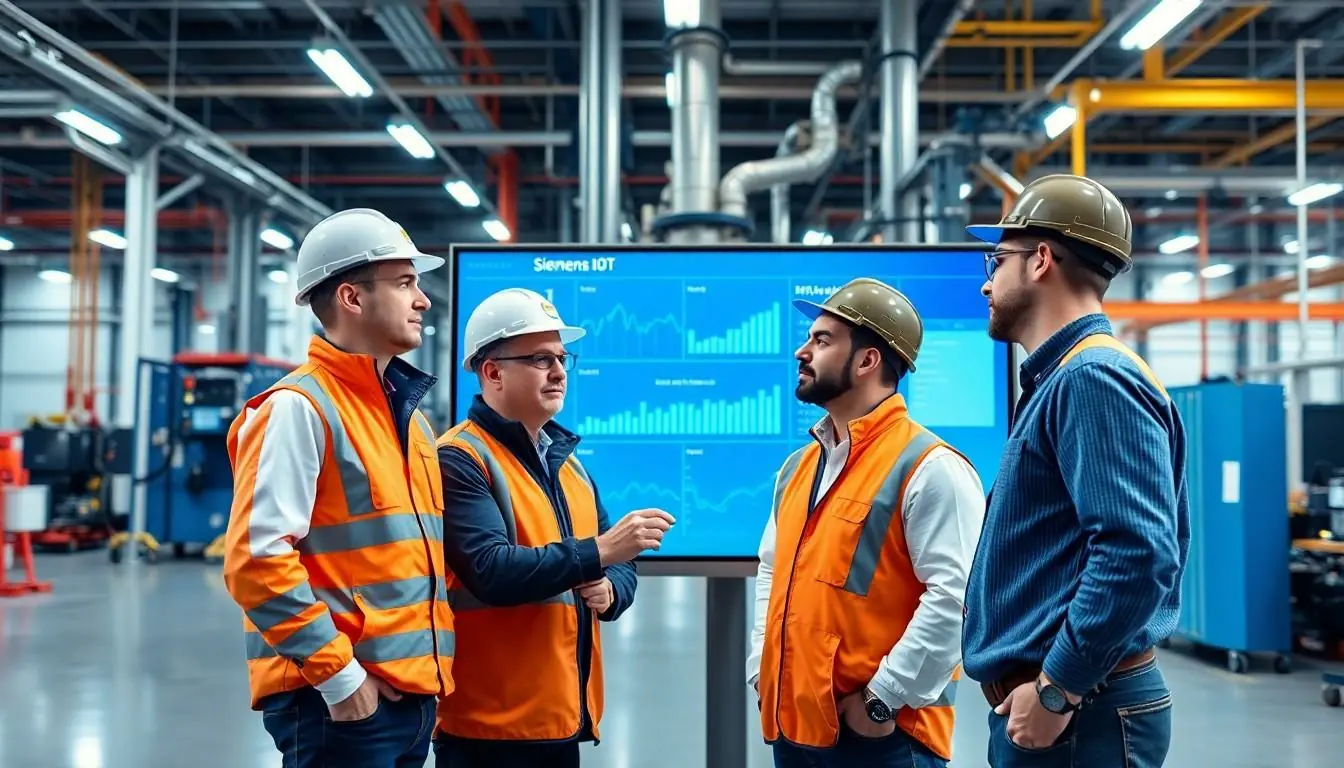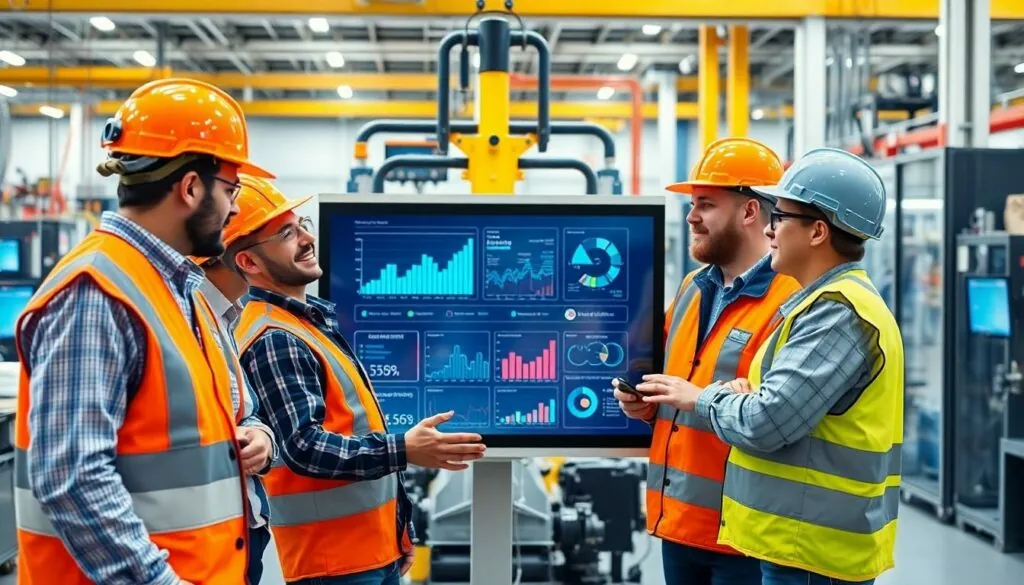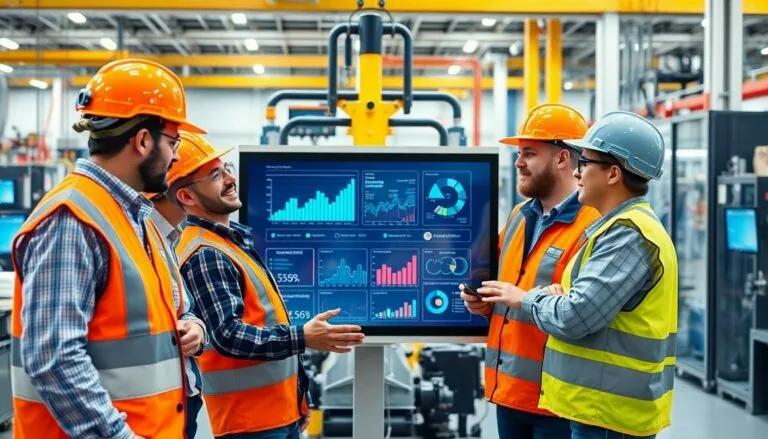Table of Contents
ToggleIn a world where everything’s getting smarter—your fridge can tell you when you’re out of milk, and your vacuum can clean while you binge-watch that new series—Siemens IoT is leading the charge into the future. Imagine a realm where industrial machines chat with each other like old friends, optimizing efficiency and reducing downtime. Sounds like a sci-fi movie, right? But it’s happening right now.
Overview of Siemens IoT
Siemens IoT transforms industries by integrating advanced digital technologies into existing infrastructure. The platform connects various devices and sensors, enabling seamless data exchange for enhanced decision-making. With real-time analytics, stakeholders can monitor performance continuously and optimize operations efficiently.
Industrial applications utilize Siemens IoT for predictive maintenance, significantly reducing costly downtime. Companies can leverage data insights to predict equipment failures before they occur. This proactive approach allows for planned maintenance schedules that improve productivity.
Another advantage lies in supply chain optimization. Siemens IoT enhances visibility across the supply chain, helping businesses track inventory levels and streamline logistics. By analyzing data from multiple sources, organizations can adjust to fluctuations in demand swiftly.
Integration with artificial intelligence systems further elevates Siemens IoT capabilities. Smart algorithms analyze massive datasets to identify patterns and suggest improvements. Manufacturers benefit from increased operational efficiency and enhanced product quality.
Energy management represents another critical aspect. Siemens IoT solutions monitor energy consumption and identify areas for conservation. This emphasis on sustainability not only lowers operational costs but also contributes to corporate social responsibility goals.
The growing ecosystem of partners and developers around Siemens IoT fosters innovation and expansion. Collaboration with various tech companies reinforces its adaptability across industries. Firms looking to embrace Industry 4.0 find Siemens IoT’s comprehensive tools and resources indispensable.
Ultimately, Siemens IoT stands at the forefront of industrial digitalization, shaping a connected future for manufacturers. Flexibility and scalability underpin its architecture, allowing diverse applications tailored to specific sector needs. As industries progress, Siemens IoT plays a pivotal role in driving efficiency and performance.
Key Features of Siemens IoT

Siemens IoT offers a range of features that enhance industrial connectivity and data analysis. Stakeholders benefit from these advanced capabilities.
Connectivity Solutions
Siemens IoT provides robust connectivity solutions for industrial environments. The platform supports a variety of communication protocols, enabling devices and sensors to link seamlessly. Users can rely on edge computing to process data closer to its source, significantly reducing latency. Operational efficiency improves as machinery shares real-time data, facilitating quicker decision-making. Connectivity extends beyond devices, supporting integration with cloud platforms for enhanced scalability.
Data Analytics Capabilities
Siemens IoT features powerful data analytics capabilities, driving smarter operational decisions. Advanced algorithms process vast datasets, uncovering insights that inform best practices. Reports generated enable stakeholders to monitor performance continuously and conduct predictive analysis, effectively anticipating maintenance requirements. By leveraging machine learning, businesses can identify trends and optimize resource allocation more effectively. Overall, data-driven strategies lead to greater productivity and improved product quality across industrial sectors.
Applications of Siemens IoT
Siemens IoT finds diverse applications across industries, significantly improving operations and driving efficiency. Its capabilities extend into multiple realms, including smart manufacturing and energy management.
Smart Manufacturing
Smart manufacturing leverages the power of Siemens IoT to enhance production processes. Connected equipment communicates in real-time, reducing response times and minimizing errors. Automation systems allow for swift adjustments to production schedules based on demand. Analytics tools monitor machine performance continuously, identifying potential issues before they escalate. These features contribute to optimized resource allocation, resulting in higher output quality. Manufacturers also benefit from insights derived from data, leading to informed decision-making and increased competitiveness. Advanced robotics integrated with Siemens IoT further streamline operations, enabling manufacturers to adapt rapidly to market changes. Overall, smart manufacturing under Siemens IoT positions industries for future success, focusing on agility and efficiency.
Energy Management
Energy management serves as a crucial application of Siemens IoT, aiming to optimize energy consumption across facilities. Real-time monitoring of energy usage empowers companies to identify inefficiencies instantly. Data analytics highlight patterns in consumption, enabling businesses to adjust operations accordingly. Sustainability initiatives become more achievable as insights lead to effective conservation strategies. Cost reductions in operational budgets arise from improved energy efficiency. Additionally, predictive analytics can identify potential energy savings opportunities, helping organizations plan for future investments. Siemens IoT solutions facilitate seamless integration of renewable energy sources, further enhancing sustainability efforts. Ultimately, energy management through Siemens IoT drives firms toward greener practices while maintaining financial performance.
Benefits of Using Siemens IoT
Siemens IoT offers significant advantages for modern industries. Enhanced efficiency ranks among the most notable benefits. Smart technologies enable interconnected machines to communicate, reducing response times and minimizing errors.
Real-time analytics empower stakeholders to monitor performance continuously. By leveraging accurate data, decision-makers can optimize operations effectively. Predictive maintenance stands out as another crucial feature. Companies can foresee equipment failures and schedule maintenance proactively, minimizing costly downtime.
Visibility across supply chains benefits from Siemens IoT integration. Businesses can assess inventory levels and logistics swiftly, adapting to demand fluctuations. Integration with artificial intelligence elevates the platform’s capabilities. Advanced algorithms analyze large datasets, identifying patterns that suggest improvements tailored to specific needs.
Connectivity solutions play an essential role in Siemens IoT. The system supports various communication protocols, ensuring seamless integration of devices and sensors. Edge computing capabilities enhance operational efficiency by processing data closer to its source, thus reducing latency significantly.
Energy management represents an important aspect of Siemens IoT solutions. Continuous monitoring of energy consumption allows for identifying conservation opportunities, promoting sustainability and lowering operational costs. The growing ecosystem of partners enhances innovation within Siemens IoT, making it adaptable across various industries.
Applications in smart manufacturing showcase significant benefits. Connected equipment communicates in real time, optimizing resource allocation and supporting swift adjustments to production schedules. Additionally, advanced robotics streamline operations, positioning industries for future success.
Energy management optimizations contribute to greener practices. Real-time monitoring and data analytics highlight inefficiencies, empowering companies to implement effective conservation strategies. Ultimately, Siemens IoT positions industries to thrive in the ever-evolving landscape of digitalization.
Challenges and Considerations
Siemens IoT presents several challenges and considerations for organizations looking to implement this technology. Security concerns arise due to the interconnected nature of devices, increasing the risk of cyberattacks. Comprehensive strategies for safeguarding sensitive data require constant vigilance and updates.
Interoperability issues may emerge as various devices and systems need to communicate effectively. Different manufacturers often use unique protocols, which can complicate integration. Organizations should assess compatibility between existing infrastructure and new IoT devices to ensure seamless communication.
Data management poses another challenge, as the volume of data generated can be overwhelming. Effective storage, processing, and analysis methods are essential for organizations to derive valuable insights from this information. Real-time analytics capabilities must evolve to handle increased data loads efficiently.
Scalability also warrants consideration. The IoT deployment should adapt as business needs change. A robust architecture that supports future expansion and integration of additional devices will enhance overall flexibility.
Cost implications factor prominently into decisions regarding Siemens IoT adoption. Organizations must evaluate initial investments against potential long-term savings and efficiency improvements. A thorough cost-benefit analysis can guide decision-making to ensure resources are allocated effectively.
Change management is crucial when incorporating Siemens IoT into existing operations. Employees may require training to navigate new technologies properly, and buy-in from all stakeholders will facilitate a smoother transition. Effective communication about the benefits of IoT helps build support throughout the organization.
Finally, regulatory compliance plays a significant role in IoT deployment. Organizations must stay informed about legal requirements related to data privacy and industry standards. Compliance efforts should align with IoT initiatives to avoid potential legal pitfalls.
Siemens IoT is revolutionizing the industrial landscape by enabling seamless connectivity and data-driven decision-making. Its advanced technologies empower businesses to enhance efficiency and optimize operations while addressing challenges like security and interoperability.
As organizations embrace this transformative platform, they position themselves for success in an increasingly digital world. The integration of real-time analytics and predictive maintenance not only boosts productivity but also supports sustainability efforts.
With a growing ecosystem of partners, Siemens IoT is set to drive innovation across various sectors. This adaptability ensures that industries can thrive amid rapid technological advancements, making Siemens IoT a vital component of the future of industrial operations.







